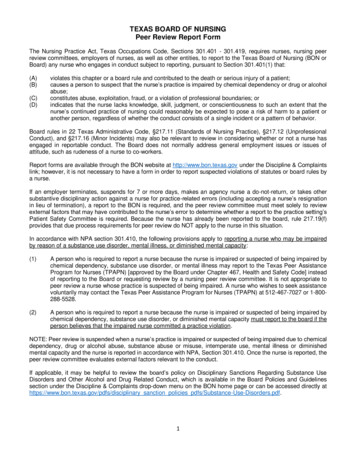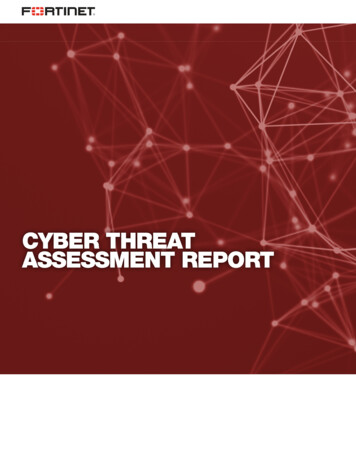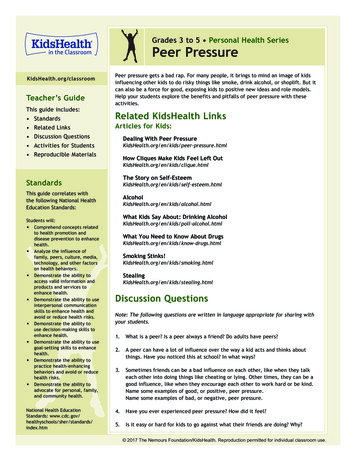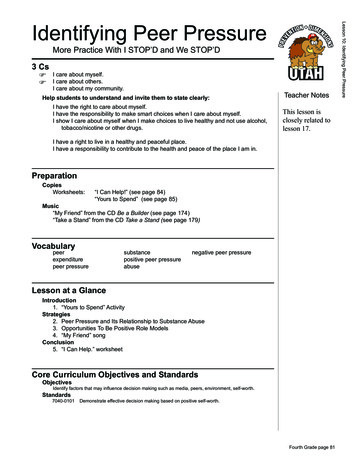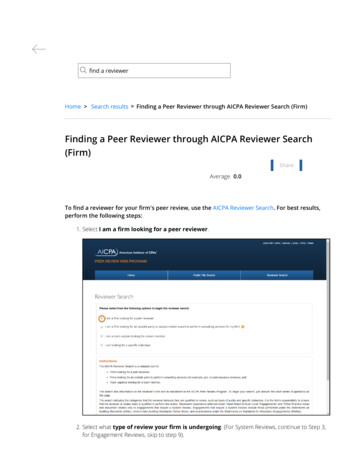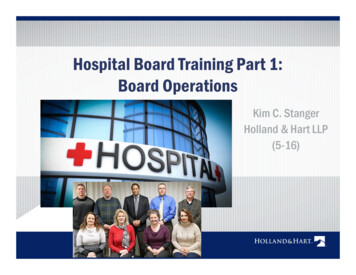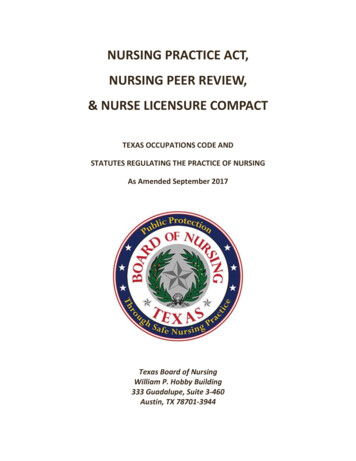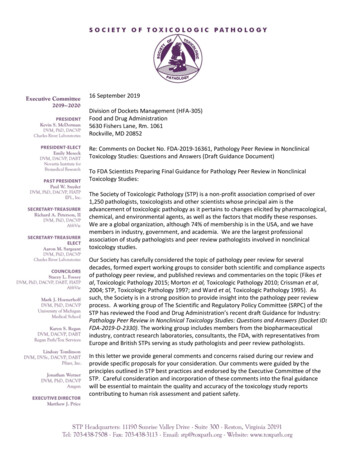
Transcription
16 September 2019Division of Dockets Management (HFA-305)Food and Drug Administration5630 Fishers Lane, Rm. 1061Rockville, MD 20852Re: Comments on Docket No. FDA-2019-16361, Pathology Peer Review in NonclinicalToxicology Studies: Questions and Answers (Draft Guidance Document)To FDA Scientists Preparing Final Guidance for Pathology Peer Review in NonclinicalToxicology Studies:The Society of Toxicologic Pathology (STP) is a non-profit association comprised of over1,250 pathologists, toxicologists and other scientists whose principal aim is theadvancement of toxicologic pathology as it pertains to changes elicited by pharmacological,chemical, and environmental agents, as well as the factors that modify these responses.We are a global organization, although 74% of membership is in the USA, and we havemembers in industry, government, and academia. We are the largest professionalassociation of study pathologists and peer review pathologists involved in nonclinicaltoxicology studies.Our Society has carefully considered the topic of pathology peer review for severaldecades, formed expert working groups to consider both scientific and compliance aspectsof pathology peer review, and published reviews and commentaries on the topic (Fikes etal, Toxicologic Pathology 2015; Morton et al, Toxicologic Pathology 2010; Crissman et al,2004; STP, Toxicologic Pathology 1997; and Ward et al, Toxicologic Pathology 1995). Assuch, the Society is in a strong position to provide insight into the pathology peer reviewprocess. A working group of The Scientific and Regulatory Policy Committee (SRPC) of theSTP has reviewed the Food and Drug Administration’s recent draft Guidance for Industry:Pathology Peer Review in Nonclinical Toxicology Studies: Questions and Answers (Docket ID:FDA-2019-D-2330). The working group includes members from the biopharmaceuticalindustry, contract research laboratories, consultants, the FDA, with representatives fromEurope and British STPs serving as study pathologists and peer review pathologists.In this letter we provide general comments and concerns raised during our review andprovide specific proposals for your consideration. Our comments were guided by theprinciples outlined in STP best practices and endorsed by the Executive Committee of theSTP. Careful consideration and incorporation of these comments into the final guidancewill be essential to maintain the quality and accuracy of the toxicology study reportscontributing to human risk assessment and patient safety.
In addition to our general comments, our principal and most extensive comments focus on six criticaltopics of the proposed guidance that have the potential to adversely disrupt the practice of toxicologicpathology as a medical diagnostic discipline. Shorter, ancillary, comments on other aspects are alsoincluded in Table 1 at the end of this letter.The six critical topics with which the STP disagrees as they relate to prospective peer review are asfollows:1) Question 5, Question 8, and Question 9: Documentation of preliminary differences of opinionand discussion in peer review statement and report: The agency’s recommendation todocument the changes made to the study pathologist’s preliminary interpretation because ofthe peer review process in the peer review statement and the pathology report.2) Question 5: Peer Review Planning Documentation: The agency’s recommendation to include thespecific details of the peer review in the study protocol/protocol amendments.3) Question 8: Testing facility tracking procedures: The agency’s recommendation to enforceprocedures to track all changes to a study pathologist’s interpretations, including changes thatmight result from a pathology peer review, as well as possible implementation of an audit trailon preliminary histopathology diagnoses.4) Question 8 and 9: Records of communication: The agency’s recommendation to retaincommunications related to the peer review.5) Question 8 (and elsewhere): Definition of transparency: Clarity is needed on what aspects of aprospective (contemporaneous) peer review the agency considers not transparent forreconstruction of the study.6) Question 9: Resolution of unresolved differences: In the event of a disagreement, the agencyrecommends that the peer review pathologist documents his/her interpretation beforeinitiating discussion with the study pathologist.We thank the FDA staff for their considerable efforts and sharing their thinking, appreciate theopportunity to provide comments, and sincerely hope that these comments will be considered inimproving this important guidance. We look forward to further dialogue and collaboration with theagency in the refinement and implementation of this guidance document.Respectfully,Kevin S. McDorman, DVM, PhD, Diplomate, ACVPPresident, Society of Toxicologic Pathology
General CommentsWhile it is true that pathology peer review practices or their documentation have not been codified inUS regulations, it is important to note that the toxicologic pathology community has carefullyconsidered both scientific and compliance aspects of pathology review and published documents relatedto pathology peer review (Fikes et al, Toxicologic Pathology 2015; Morton et al, Toxicologic Pathology2010; Crissman et al, 2004; STP, Toxicologic Pathology 1997; and Ward et al, Toxicologic Pathology1995). These publications have provided a strong basis for both the scientific conduct of a pathologypeer review of toxicology studies, as well as the appropriate documentation practices to allow studyreconstruction.The current draft FDA guidance references several of these publications and we appreciate that incertain questions portions of these recommendations have been adopted; however, as described belowthere are several key recommendations in the guidance which are in conflict with both currentlyaccepted best practice and our interpretation of the definition of anatomic pathology raw data.The STP considers the peer review process to be an integral component of pathology reporting ensuringthe integrity of the pathology data in safety studies, and encouraging consistency of diagnostic criteria,and the use of INHAND/SEND terminology. While we appreciate the agency’s desire to be assured thatprimary pathologists are not unduly influenced during the peer review process, some of the processessuggested for prospective (contemporaneous) peer review in this draft guidance will lengthen andcomplicate the reporting process, and will likely result in pathology narratives which may be unclear,contradictory, and confusing to non-pathologists. As such, we urge caution in implementingcumbersome documentation practices that will detract from the overall quality of the peer reviewprocess and study report, may discourage some from conducting pathology peer reviews, and still notachieve the stated goal of limiting undue influence during pathology evaluations. We believe that a lackof performing peer reviews is more likely to lead to negative implications for patient safety.As the largest industry stakeholder of professional study pathologists and peer review pathologists, theSTP is very interested in working with the Agency to provide guidance that retains the definition ofhistopathology raw data (defined as the final signed and dated pathology report); while at the sametime easing the Agency’s concerns about transparency and offering clarity on the prospective(contemporaneous) pathology peer review process. Ideally, this solution would not cause detrimentaleffects on report quality and processes and allow for the degree of transparency the Agency desires.We look forward to further dialogue and cooperation with the Agency in developing appropriateprocesses that avoid the risk of reducing pathology report quality.
Topic #1:Question 5, Question 8, and Question 9: Documentation of preliminary differences of opinion anddiscussion in peer review statement and report: The agency’s recommendation to document thechanges made to the study pathologist’s preliminary interpretation because of the peer review processin the peer review statement and the pathology report.FDA Proposals - Topic #1:A5, Lines 154-156: “Any changes to the overall study interpretations by the study pathologist because ofa prospective peer-review process should be documented in the peer-review statement and discussed inthe final pathology report, as applicable.”A5, Lines 161-164: “Unresolved differences in interpretation from the final or draft pathology reportshould be clearly identified in the peer-review statement. Resolution of any differences should bediscussed in the final pathology report or in an amendment to the final pathology report, and the processof resolution should be documented (discussed further in Q8 and Q9).”A8, Lines 189-192: “Therefore, the testing facility management should implement appropriate measuresto ensure independence of the study pathologist and enforce procedures to track all changes to a studypathologist’s interpretations, including changes that might result from a pathology peer review. Suchprocedures can include the implementation of an audit trail”.A8, Lines 204-208: “To best ensure transparency, documents (e.g., worksheets, electronic files) thatrecord peer-review events and changes to the study pathologist’s findings should be retained in the studyrecords. One option to ensure transparency is to fix or lock the database of pathology findings before thestart of the peer-review process to ensure that changes to the pathology findings will be recorded in anaudit trail.”A8, Lines 211-212: “Also, the peer-review statement should clearly identify changes resulting from thepeer-review process that affect the study pathologist’s interpretations.”A9, Lines 218-222: “If the peer-review pathologist does not concur with the study pathologist’sinterpretations, then changes to the interpretations might be made by the study pathologist to reflectconsensus with the peer-review pathologist”.A9, Lines 227-230: “Depending upon the directives of the SOPs, consensus may be achieved throughconsultation with additional experienced pathologists. Records of communications pertinent to theprocess of slide evaluation and records of meeting summaries (e.g., meeting minutes) relevant to thepathology peer review should be retained in the study file.”STP Proposal for Topic #1: We submit that for those cases where preliminary differences are resolvedduring prospective peer review, additional documentation is not warranted. We suggest deleting thesenew documentation practices from the guidance. Our rationale for this approach follows.
Rationale: Changes to pathology interpretations due to prospective peer review are a part of theiterative process of refining pathology diagnoses. In the majority of peer reviews, preliminarydifferences between the primary and peer review pathologist are resolved during the consensusprocess. Because the pathology observations are not considered raw data until the study pathologisthas signed the pathology report, and there is no requirement in the GLP’s for retention of pathologynotes, additional documentation beyond the peer review statement is not warranted. This is in contrastto retrospective peer review, where the pathology data have been finalized and are considered rawdata. In those cases, we fully agree that it is important the amended pathology report clearly indicatewhat, if any, changes were made as a part of the retrospective peer review.Currently the Agency’s prescriptive process recommends multiple new levels of peer reviewdocumentation and auditing above and beyond the current definition of histopathology raw data. Whilethese measures may provide for an element of the stated transparency the agency desires, they will notallow a determination of undue influence on the pathology evaluation process, and as described above,are anticipated to have significant unintended consequences for the pathology reporting process.Specifically, many test facilities will interpret the guidance in a conservative manner, resulting in theimposition of additional, new requirements including: Locking the pathology database prior to peer review; Retention of the peer review pathologist’s diagnoses; Retention of peer review documents in the study records including documenting how the twopathologists came to consensus; Clearly identify significant changes and “interpretations” (the guidance does not define“significant” or how “interpretations” differ from tabulated histologic findings) that result fromthe peer review process in the final study report.In our society’s assessment, these will (1) conflict with existing definitions of pathology raw data whilenot contributing to the reconstruction of the study report by making preliminary diagnoses of the studypathologist raw data (2) decrease the clarity and quality of anatomic pathology narrative reports sinceboth original (preliminary) and final interpretations would be reported, and (3) have detrimental impacton the efficiency and timeliness of toxicology report generation which is an important component oftimely drug development. To avoid the undue burden of the proposed extensive peer reviewdocumentation and auditing, we are concerned that many organizations will discontinue the practice ofpeer review altogether, which will negatively impact the quality of human risk assessment and patientsafety.
Topic #2:Question 5: Peer Review Planning Documentation: The recommendation to include the specific detailsof the peer review in the study protocol/protocol amendments.FDA Proposal - Topic #2:A5, Lines 126-129: “An SOP and GLP study protocol (or protocol amendments) should include adescription of the peer-review procedure, including selected target tissues, the dose groups to beexamined, the number of specimens to be examined in each group, and whether the peer review shouldbe conducted in a blinded fashion. Relevant SOPs can be referenced where appropriate.”A5, Line 131: “The peer-review statement should include the following information: .”STP Proposal for Topic #2: We propose that the underlined information in lines 126-129 not berequired in a GLP study protocol or amendments, but that it be documented in the peer reviewstatement (memo) as is already common best practice and consistent with OECD Advisory DocumentNo. 16 (OECD 2014). Some of the information listed (e.g., selection of potential target tissues) can alsonot be listed in an SOP a priori for a given study, as described below. Transparency is assured byrelevant SOPs detailing the peer review process, and the study protocol stating that (1) acontemporaneous pathology peer review will occur; (2) referencing the relevant SOP describing theprocess; (3) and that the peer review statement summarizing the details of the peer review will beissued. It is standard practice that information provided in SOPs does not need to be repeated withinthe study protocol.In addition, this portion of the draft guidance suggests that peer review may be performed in a blindedfashion. We recommend deleting the wording about the blinded peer review, because this is notconsidered best practice for nonclinical toxicologic pathology assessments (Crissman et al 2004, Mortonet al, 2010).Rationale: Specific tissues and groups of animals to be peer reviewed cannot be determined a priori atthe time of protocol generation and are determined based on the overall preliminary findings of thestudy pathologist. To assure a quality study report per best scientific practices, it is best to not limit thepeer reviewer’s ability to assess as many tissues as needed to assure an adequate peer review. Asoutlined in Fikes et al, 2015, SOPs should define the minimal materials for an appropriate peer reviewand allow for sufficient flexibility in review of additional materials to achieve the peer review objectives.The peer review pathologist should be able to review additional materials as appropriate based on thefindings in a study without requiring additional protocol amendments, and the specific details of theevaluation should be documented within the peer review memo.The agency recommendation to duplicate the content in the SOP and the protocol does not reflectstandard practice across GLP study areas where information provided in SOPs are not repeated withinthe study protocol. An unintended consequence of the proposed language would be increased volumeof protocol amendments on nearly every study for procedures that are already well described in an SOP,without adding value but cause substantial administrative burden to the study director, studypathologist, peer review pathologist, and quality assurance auditors. The unnecessary duplication of
information documented in various locations (i.e., SOP, the protocol, study report and the peer reviewstatement) will complicate the study records and makes effective auditing more challenging, increasingthe chances for clerical errors arising from synchronization of disparate documents.It is not appropriate to conduct a routine pathology peer review in a blinded fashion, and the topic isoutside the scope of this guidance. Effective peer review involves review of the draft pathology reportand knowledge of other relevant study data, such as organ weights, macroscopic necropsy observations,clinical signs, clinical pathology and treatment group/exposure levels.Topic #3:Question 8: Testing facility tracking procedures: The agency’s recommendation to enforce proceduresto track all changes to a study pathologist’s interpretations, including changes that might result from apathology peer review, as well as possible implementation of an audit trail on preliminaryhistopathology diagnoses.FDA Proposal - Topic #3:A8, Lines 189-192: “Therefore, the testing facility management should implement appropriate measuresto ensure independence of the study pathologist and enforce procedures to track all changes to a studypathologist’s interpretations, including changes that might result from a pathology peer review. Suchprocedures can include the implementation of an audit trail.”STP Proposal for Topic #3: We recommend omitting this recommendation from the guidance.Rationale: The study pathologist is accountable for the pathology report as he/she is the only onegenerating raw data because he/she is the only one signing the pathology report (which constitutes theraw data). Procedures are commonly followed across the industry such as (a) use of SOPs describingprocedures such as Pathology Working Groups (PWG) when there are significant differences ininterpretation, and (b) retention of histopathological specimens such as blocks, tissues, and slides asindicated in the FDA 1987 GLP rule preamble. These procedures allow for resolution of disagreementsand preservation of durable specimens from which interpretations and conclusions can be verified atany time in the future, as noted in the 1987 Preamble.There is also ambiguity regarding the use of “audit trail” to track changes in “interpretation” (which isnot the same as diagnoses recorded in an electronic capture system). If “interpretation” refers only tothe changes made to the pathologist’s narrative report, it is not captured in an audit trail. Typically,audit trail pertains to capturing any changes to any diagnostic term, severity grade, or qualifier withinelectronic capture systems or pathology tables, and not the “interpretation” of those diagnoses. Inaddition, it is not necessary for the peer review and study pathologists to agree on every diagnosis orseverity/qualifier classification, and minor differences in terminology, incidence and severity grading ofdiagnoses are to be expected and are acceptable (Morton et al, 2010). If the goal is to capture allchanges to the entries originally placed into the GLP electronic capture system, we are concerned thatthe proposed guidance seems to shift the definition of pathology raw data (which is the final signedreport as per FDA 1987 GLP rule Preamble) to preliminary diagnoses as they become defensible byhaving to be justified. This makes it necessary to audit the tracking of all changes to preliminary entries
(electronic capture system) and “interpretations” (draft pathology report), which adds significantadministrative burden and does not “ensure the independence of the study pathologist” beyond existingpractices.Topic #4:Question 8 and 9: Records of communication: The agency’s recommendation to retaincommunications related to the peer review.FDA proposals - Topic #4:A8, Lines 198-200 and repeated in A9 Lines 228-230: “Records of communications pertinent to theprocess of slide evaluation and meeting summaries (e.g., meeting minutes) relevant to the pathologypeer review should be retained in the study file.”STP Proposal for Topic #4: We recommend that the guidance clarifies that the meeting minutes tocapture are limited to the discussion of processes, plans, and expectations linked to the peer review andnot the precise discourse over the evaluation itself, as explained in Fikes et al, 2015 and below in therationale.Rationale: The signed peer review statement/memo authored by the peer review pathologist canconcisely explain or capture the scope and extent of peer review conducted for a given study. Theessential correspondence to retain are those that reflect the processes, plans, and expectations directlylinked to the slides used in the peer review, especially those that are not captured in other studycommunications. Examples may include correspondence on the process involved in the selection of theslides for review, the selection of animals for full slide review, and the review of additional potentialtarget tissues. Communications regarding preliminary observations (pathology diagnoses that are notlocked or signed) and preliminary pathology interpretations would not be required to be maintainedsince these are pathology working notes (per 1987 GLP rule Preamble, these are not raw data becausethey do not contribute to study reconstruction).Topic #5:Question 8 (and elsewhere): Definition of transparency: Clarity is needed on what aspects of aprospective (contemporaneous) peer review the agency considers not transparent for reconstruction ofthe study.FDA Proposals - Topic #5:A8, Lines 204-208: “To best ensure transparency, documents (e.g., worksheets, electronic files) thatrecord peer-review events and changes to the study pathologist’s findings should be retained in the studyrecords. One option to ensure transparency is to fix or lock the database of pathology findings before thestart of the peer-review process to ensure that changes to the pathology findings will be recorded in anaudit trail.”STP Proposal for Topic #5: We recommend omitting this paragraph.
Rationale: We agree that transparency and integrity are critical to all datasets including non-numericalendpoints such as histopathology. We believe that the existing GLP procedures ensure the accuracy andintegrity of the pathology raw data, and offers transparency as stated in the preamble of 1987 GLP rule.Unlike many other specimens, histopathology specimens (blocks, tissues, and slides) are retained andthe slides are available for re-evaluation at any time, including by regulatory authority personnel, sotransparency is assured. Further, the FDA has the authority to interview all contributing scientists,including the study and peer-review pathologists during an inspection, and review any histopathologyspecimens.This guidance appears to imply that peer review pathologist’s and/or study pathologist’s peer reviewnotes should be retained in the study records, which is inconsistent with the current definition ofpathology raw data per FDA 1987 GLP final rule and OECD No. 16, Section 2.4 (OECD 2014 which states“Notes made by the peer review pathologist which are used to record observations during thehistopathological examination of individual slides do not normally have to be retained in the study file.”)Topic #6:Question 9: Resolution of unresolved differences: In the event of a disagreement, the agencyrecommends that the peer review pathologist documents his/her interpretation before initiatingdiscussion with the study pathologist.FDA Proposal - Topic #6:A9, Lines 218-222: “If the peer-review pathologist does not concur with the study pathologist’sinterpretations, then changes to the interpretations might be made by the study pathologist to reflectconsensus with the peer-review pathologist. The difference in interpretation should be documented bythe peer-review pathologist before engaging in a dialogue to resolve the interpretative differences.”STP Proposal for Topic #6: We recommend deleting the underlined sentence in lines 220-222 andinstead focusing on SOPs and other established processes to resolve and document disagreement asreferred to in lines 227-228: “Depending upon the directives of the SOPs, consensus may be achievedthrough consultation with additional experienced pathologists.”Rationale: The proposal to provide documentation from the peer review pathologist “before” engagingthe study pathologist is too prescriptive and potentially counter-productive since this may involvedocumentation of incorrect preliminary interpretations which will lead to confusion. Peer review istypically a collegial exchange between medical professionals and requiring prior written communicationbefore colleagues can speak with each other will not increase the quality of the peer review and willonly add time, confusion and undue administrative burden. In addition, the proposed guidance isinconsistent with GLP 1987 GLP final rule that “notes are not necessary for the reconstruction” andOECD No. 16, Section 2.4 (OECD 2014) which states “Notes made by the peer review pathologist whichare used to record observations during the histopathological examination of individual slides do notnormally have to be retained in the study file.”This guidance does not seem to consider that if there is disagreement on the overall interpretation ofthe pathology evaluation (i.e., target organs, the no-effect level, adversity of test article-related findings)
then the prospective peer review is not completed. The overall goal is to achieve agreement, and oncethere is agreement (which is very often easily achieved between the study and peer reviewpathologists), the study pathologist will sign the pathology report and the peer review pathologist willsign the peer review statement as suggested in Answer 5, Lines 148-152 : “If the peer-review pathologistconcurs with the study pathologist’s diagnoses and interpretations, the peer-review statement might notinclude a comprehensive analysis of the outcome of the peer review. Under these conditions, a statementthat a peer review was conducted and that the final pathology report reflects the consensus opinions ofthe study pathologist and peer-review pathologist would suffice.”If an agreement cannot be reached, then SOPs should be in place outlining the processes used toachieve agreement along the theme outlined by the agency in lines A9 227-228: “Depending upon thedirectives of the SOPs, consensus may be achieved through consultation with additional experiencedpathologists.” We suggest that focusing on this process may help the agency achieve the desiredadditional transparency. In this instance, the nature of the disagreement (e.g., individual diagnoses oroverall interpretation), the pathologists involved/consulted, and how the disagreement was resolvedcould be documented in the peer review statement.References:Crissman, J. W., Goodman, D. G., Hildebrandt, P. K., Maronpot, R. R., Prater, D. A., Riley, J. H., Seaman,W. J., Thake, D. C. (2004). Best practices guideline: Toxicologic histopathology. Toxicol Pathol 32, 126–31.Fikes, J. D., Patrick, D. J., Francke, S., Frazier, K. S., Reindel, J. F., Romeike, A., Spaet, R. H., Tomlinson, L.,and Schafer, K. A. (2015). Scientific and Regulatory Policy Committee Review: Review of the Organisationfor Economic Co-operation and Development (OECD) Guidance on the GLP Requirements for PeerReview of Histopathology. Toxicol Pathol, 43, 907-914Morton, D., Sellers, R., Barale-Thomas, E., Bolon, B., George, C., Hardisty, J., Irizarry, A., McKay, J. S.,Odin, M., and Teranishi, M. (2010). Recommendations for pathology peer review. Toxicol Pathol 38,1118–27OECD (Organisation for Economic Co-operation and Development). (Issued December 15, 2014). OECDSeries on Principles of Good Laboratory Practice and Compliance Monitoring: No. 16, AdvisoryDocument of the Working Group on Good Laboratory Practice—Guidance on the GLP Requirements forPeer Review of Histopathology. Accessed September 01, 2019 splaydocumentpdf/?cote env/jm/mono(2014)30&doclanguage enThe Society of Toxicologic Pathologists (1997) Documentation of pathology peer review. Position of theSociety of Toxicologic Pathologists. Toxicol Pathol 25 (6): 655.U.S. FDA (United States Food and Drug Administration) (1987). Good laboratory practice regulations;Final rule. Federal Register 52, 33768–82.Ward J. M., Hardisty J. F., Hailey J. R., Streett C. S. (1995). Peer review in toxicologic pathology. ToxicolPathol 23, 226–234.
Table 1: Society of Toxicologic Pathology: Ancillary Comments on FDA Draft Guidance on Pathology Peer ReviewSection orAnswer: Line(s)Referenced TextComment/IssueRecommended Change/Solution/LanguageBackground:36“ .includes an initial read of tissueslides by the study pathologist .”Although the term “read” is used colloquially for a pathologist’sevaluation of tissues, a better term would be “evaluation” sincethey do not just record what they see, but rather they use theirtraining, experience and understanding of the range of normaltissue morphologies, incidental observations, pathophysiology andother relevant study data to evaluate what they see under themicroscope and provide a considered judgement of the
Rationale: Changes to pathology interpretations due to prospective peer review are a part of the iterative process of refining pathology diagnoses. In the majority of peer reviews, preliminary differences between the primary and peer revi


